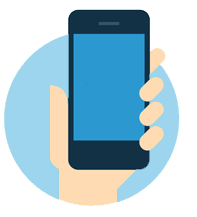Attention Span of a Goldfish... Sounds Fishy
Posted on June 23, 2015
By Theresa Chiechi, Designer, Illustrator, Writer

 Have you ever moved from task to task because you can’t seem to stay focused enough to finish one? Do you find yourself on your iPhone while watching TV or searching on a different web tab while “watching” a video on YouTube? If so, there’s no need to worry about having contracted a new disease that affects your attention span. Recent studies have shown that that sort of behavior is completely normal for humans as of late. According to a study done by Microsoft, where they monitored 2,000 people in Canada and studied the brain activity of 112 others using EEG scans, a person’s attention span has dropped from 12 seconds in 2000 to eight seconds. This somewhat alarming decrease, a 33 percent decline in a mere 15 years, is credited to none other then people’s copious usage of smartphones.
Have you ever moved from task to task because you can’t seem to stay focused enough to finish one? Do you find yourself on your iPhone while watching TV or searching on a different web tab while “watching” a video on YouTube? If so, there’s no need to worry about having contracted a new disease that affects your attention span. Recent studies have shown that that sort of behavior is completely normal for humans as of late. According to a study done by Microsoft, where they monitored 2,000 people in Canada and studied the brain activity of 112 others using EEG scans, a person’s attention span has dropped from 12 seconds in 2000 to eight seconds. This somewhat alarming decrease, a 33 percent decline in a mere 15 years, is credited to none other then people’s copious usage of smartphones.
The even scarier fact is that now our attention span is supposedly one second shorter than that of a goldfish. It may seem concerning that humans have a shorter attention span then our aquatic friends that do nothing more then swim about in a bowl of water all its life but it’s not all bad news. The silver lining is that even though the information overload we get from our smartphone devices is making it harder for us to focus on one task for long spans of time, our brains are adapting and are able to multitask way more effectively. The study by Microsoft also shed some light on the different types of attention. Attention comes in different forms and varies depending on the task that needs to be completed. Microsoft found that there are three types of attention:
The even scarier fact is that now our attention span is supposedly one second shorter than that of a goldfish.
Sustained Attention
Sustained Attention is the prolonged maintaining of one’s focus during repetitive tasks. This form of attention is the type that’s unfortunately suffering. Our consumption of media is making it harder for us to concentrate on one task for long spouts of time; it’s speculated that this is the case because people love new things. People love finding new pieces of information and they want it fast.
Selective Attention
Selective attention allows us to ignore distractions. People’s selective attention seems to be unscathed, that is unless you suffer from multi-screening. If you find yourself using a second screen (for example watching TV and using your phone or laptop at the same time), you may have more difficulty filtering out distractions. This could effect you when crossing the street and not being able to dodge an oncoming car because you were too occupied with your cellphone.
Alternating Attention
Alternating Attention is the ability to efficiently switch from task to task. The good news is that our addiction to smartphones is actually helping us with this type of attention; it’s improving our ability to multitask.
What people should take away from this study is that smartphones and technology aren’t anything to be afraid of. Smartphones aren’t rotting away at your brain and turning people into mindless zombies. While too much, of anything, isn’t good (studies have shown that people under 30 have shown signs of addictive behavior with respects to their smartphones) and you should distinguish when it is or it isn’t appropriate to use your phone, a healthy usage of smartphones can have beneficial effects. It’s an effective way to train your brain to multitask. There’s nothing wrong with a healthy usage of smartphones but when driving or engaging in conversation, it’s best to keep those phones in your pockets.
Concerned about your attention span? Test your concentration with this 5 minute quiz.
Join Our Blog Community
@CSDesignworks


